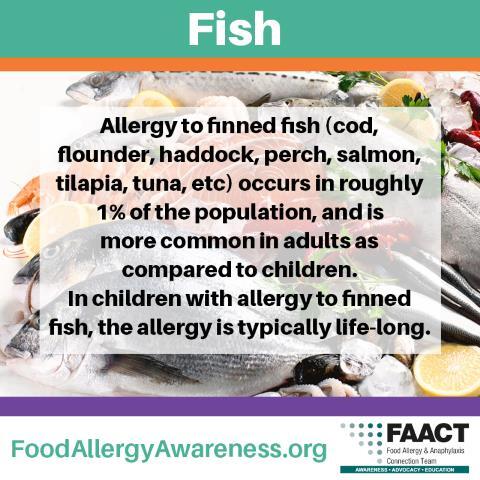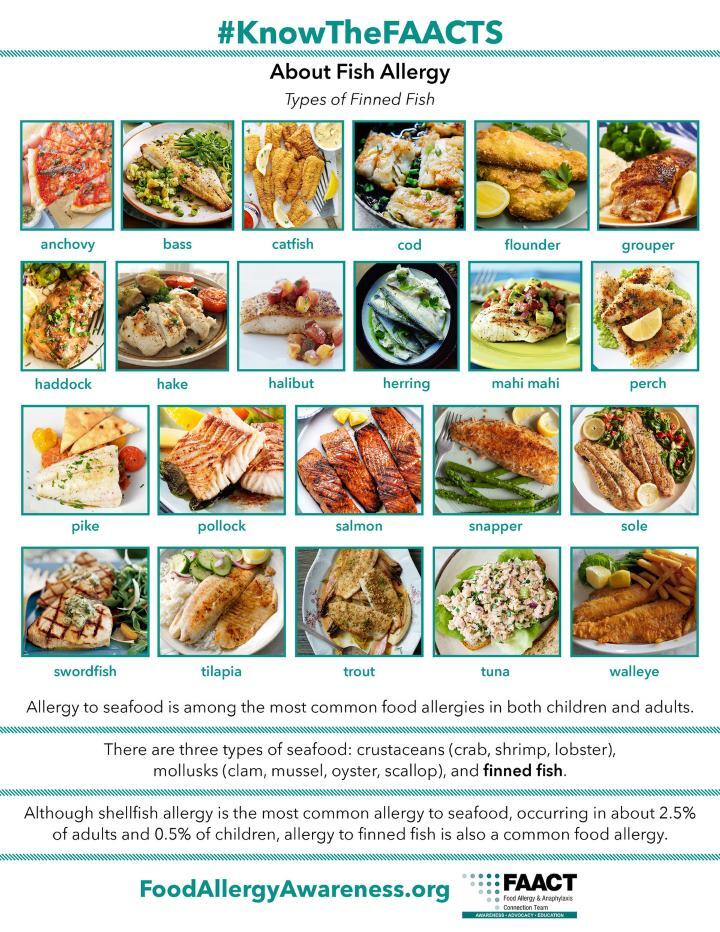Fish
Subcategories

Fish
Allergy to seafood is among the most common food allergies in both children and adults. There are three types of seafood: crustaceans (crab, shrimp, lobster), mollusks (clam, mussel, oyster, scallop), and finned fish (cod, flounder, haddock, perch, salmon, tilapia, tuna, etc). Although shellfish allergy is the most common allergy to seafood, occurring in about 2.5% of adults and 0.5% of children, allergy to finned fish is also a common food allergy.
Allergy to finned fish occurs in roughly 1% of the population, and is more common in adults as compared to children. In children with allergy to finned fish, the allergy is typically life-long. Furthermore, 40-60% of the time the allergy is developed during adulthood, and these individuals are also unlikely to experience resolution of the allergy. Since the allergenic protein (parvalbumin) in finned fish is similar regardless of the type of fish, greater than half of individuals who are allergic to finned fish are allergic to more than one type of fish. Although any type of fish can cause allergy, the most common types implicated in allergy are salmon, tuna, and halibut.
Allergic reactions to finned fish account for a significant percentage of serious allergic reactions to food. Roughly half of reactions require urgent medical evaluation. Death has also been reported from reactions to finned fish. For these reasons, all individuals with allergy to finned fish should carefully read labels and carry epinephrine at all times. It is also important to realize that respiratory and systemic reactions have been reported to exposure to finned fish protein that can become airborne in steam. This is unusual for most allergens and requires particular vigilance for individuals with allergy to finned fish. It is therefore sometimes recommended that individuals with allergy to finned fish avoid seafood restaurants where finned fish is being commonly used as an ingredient.
If there is concern for allergy to finned fish, consultation with a board-certified allergist is recommended. Special consideration needs to be made while making the diagnosis, because the method of preparation of the fish may have a significant impact on the allergenicity of the fish. Diagnostic testing, such as skin prick testing, may therefore have a higher than typical rate of false-negative results. Based on the history and evaluation, a physician-supervised oral food challenge may be necessary to make a correct diagnosis. It is also important to differentiate between immune-mediated allergic reactions versus a toxic reaction (scombroid poisoning) or infectious reaction such as food poisoning.
It is also important to note that an allergy to finned fish is not a risk factor for a reaction to radio-contrast media, which is commonly used in imaging studies in medicine (CT scans, MRIs, etc).

Types of Finned Fish
- Anchovy
- Bass
- Catfish
- Cod
- Flounder
- Grouper
- Haddock
- Hake
- Halibut
- Herring
- Mahi mahi
- Perch
- Pike
- Pollock
- Salmon
- Snapper
- Sole
- Swordfish
- Tilapia
- Trout
- Tuna
- Walleye
Practical Tips
It is recommended to always carry at least two (2) epinephrine devices at all times if you have been diagnosed with a food allergy, including allergy to finned fish. This is in case one misfires or if symptoms recur and a second dose is needed. If an epinephrine device has been used, always seek emergency medical assistance immediately. This is due to the possibility of a biphasic reaction. A biphasic reaction is when a second wave of symptoms occurs. This typically happens from 2-6 hours following the initial reaction.
Read all product labels prior to the consumption of a new food product. Before consuming any products, it is important to always read labels carefully to ensure the safety of food products. All food products that contain fish protein as an ingredient are required by FALCPA law to list the specific fish on the product label. Please note, manufacturing practices may change without notice. According to the Food Allergen Labeling and Consumer Protection Act (FALCPA), food products with the advisory statements such as “may contain,” “processed in the same plant,” or “manufactured on the same line” on a package are completely voluntary, and can be ambiguous. The true level of contamination is not declared, and may range from parts per million to micrograms. There may be different risks associated with these levels. It is generally recommended to avoid products with such labeling because of this uncertainty, but you should discuss with your board-certified allergist which particular labels should be avoided.
Visiting restaurants can be a pleasant experience for family and friends to gather together. However, some restaurants may pose as a risk. Seafood restaurants are considered high risk for individuals with allergy due to finned fish. Individuals also need to be aware of the risk of respiratory or systemic reactions to airborne protein. Please review our 'Dining Out' page for tips on how to manage visiting a restaurant. Be vigilant, ask questions, and if there is any doubt, don’t eat the food item in question.
AVOID foods that contain or may contain fish ingredients, such as:
- Caesar dressing
- Caesar salad
- Bouillabaisse
- Imitation crab
- Fish stock
- Seafood flavorings
- Worcestershire sauce
NOTE: Please keep in mind in a culturally diverse world, different ingredients may be used in different recipes. Always use extreme caution.
Other pages that may be of interest:
Visit FAACT's CROSS-CONTACT page to review how to properly clean allergens from hands and surfaces.

